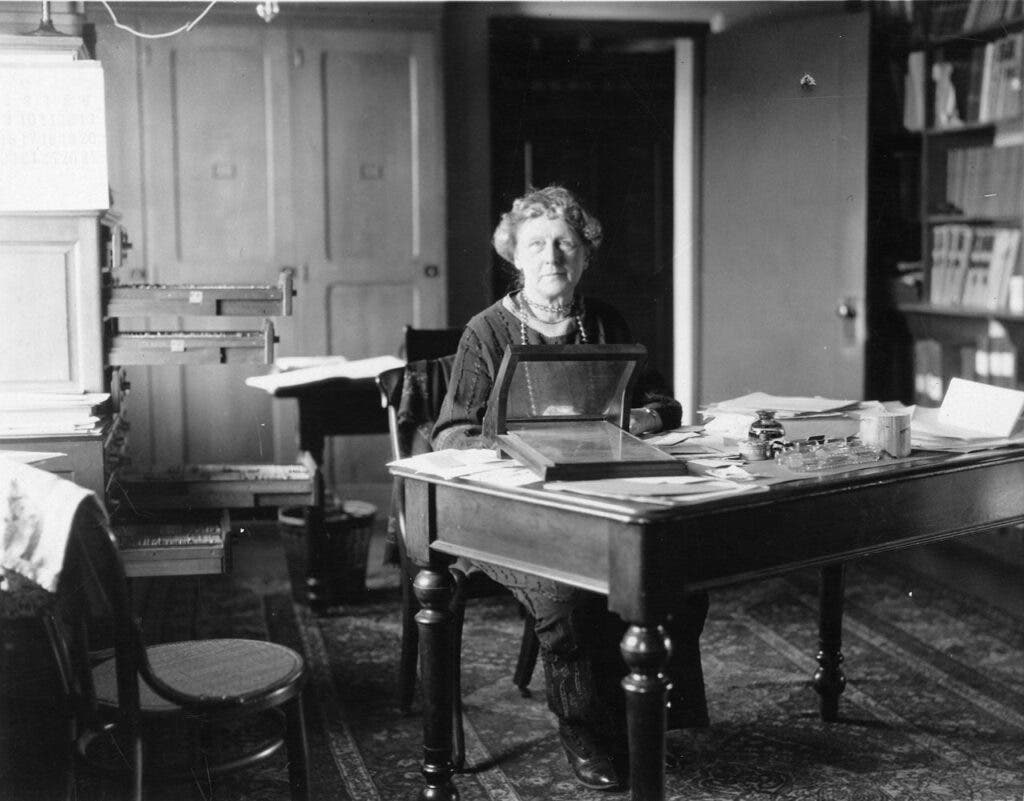It is striking that today, we can not only discover but even classify stars that are light-years from Earth — sometimes, even billions of light-years away. Stellar classification often uses the famous Hertzsprung–Russell diagram, which summarises the basics of stellar evolution. The luminosity and the temperature of stars can teach us a lot about their life journey, as they burn their fuel and change chemical composition.
We know that some stars are made up mostly of ionised helium or neutral helium, some are hotter than others, and we fit the Sun as a not so impressive star compared to the giants. Part of that development came from Annie Jump Cannon’s contribution during her long career as an astronomer.
On the shoulders of giantesses
Cannon was born in 1863 in Dover, Delaware, US. When she was 17 years old, thanks to her father’s support, she managed to travel 369 miles all the way from her hometown to attend classes at Wellesley College. It’s no big deal for teens today, but back then, this was an imaginable adventure for a young lady. The institution offered education exclusively for women, an ideal environment to spark in Cannon an ambition to become a scientist. In 1884, she graduated and later in 1896 started her career at the Harvard Observatory.
In Wellesley, she had Sarah Whiting as her astronomy professor, who sparked Cannon’s interest in spectroscopy:
“… of all branches of physics and astronomy, she was most keen on the spectroscopic development. Even at her Observatory receptions, she always had the spectra of various elements on exhibition. So great was her interest in the subject that she infused into the mind of her pupil who is writing these lines, a desire to continue the investigation of spectra.”
Whiting’s obituary in 1927, Annie Cannon.
Cannon had an explorer spirit and travelled across Europe, publishing a photography book in 1893 called “In the footsteps of Columbus”. It is believed that during her years at Wellesley, after the trip, she got infected with scarlet fever. The disease infected her ears and she suffered severe hearing loss, but that didn’t put an end to her social or scientific activities. Annie Jump Cannon was known for not missing meetings and participating in all American Astronomical Society meetings during her career.
OBAFGKM
At Radcliffe College, she began working more with spectroscopy. Her first work with southern stars spectra was later published in 1901 in the Annals of the Harvard College Observatory. The director of the observatory, Edward C. Pickering chose Cannon as the responsible for observing stars which would later become the Henry Draper Catalogue, named after the first person to measure the spectra of a star.

The job didn’t pay much. In fact, Harvard employed a number of women as “women computers” that processed astronomic data. The women computer at Harvard earned less than secretaries, and this enabled researchers to hire more women computers, as men would have need to be paid more.
Her salary was only 25 cents an hour, a small income for a difficult job to look at the tiny details from the spectrographs, often only possible with magnifying glasses. She was known for being focused (possibly also influenced by her deafness), but she was also known for doing the job fast. Simply put,
During her career, she managed to classify the spectra of 225,000 stars. At the time, Williamina Fleming, a Scottish astronomer, was the Harvard lady in charge of the women computers. She had previously observed 10,000 stars from Draper Catalogue and classified them from letters A to N. But Annie Jump Cannon saw the link between the stars’ temperature and rearranged Fleming’s classification to the OBAFGKM system. The OBAFGKM system divides the stars from the hottest to the coldest, and astronomers created a popular mnemonic for it: “Oh Be A Fine Guy/Girl Kiss Me”.

Legacy
“A bibliography of Miss Cannon’s scientific work would be exceedingly long, but it would be far easier to compile one than to presume to say how great has been the influence of her researches in astronomy. For there is scarcely a living astronomer who can remember the time when Miss Cannon was not an authoritative figure. It is nearly impossible for us to imagine the astronomical world without her. Of late years she has been not only a vital, living person; she has been an institution. Already in our school days she was a legend. The scientific world has lost something besides a great scientist.”
Cecilia Payne-Gaposchkin in Annie Jump Cannon’s obituary.

Annie Jump Cannon was awarded many prizes, she became honorary doctorate of Oxford University, the first woman to receive the Henry Draper Medal in 1931, and the first woman to become an officer of the American Astronomical Society.
Her work in stellar classification was followed by Cecilia Payne-Gaposchkin, another dame of stellar spectroscopy. Payne improved the system with quantum mechanics and described what stars are made of.
Very few scientists have such a competent and exemplary career as Cannon. Payne continued the work left from Cannon, her advisor, Henry Norris Russell, then improved it with minimum citation. From that, we got today’s basic understanding of stellar classification. Her beautiful legacy has been rescued recently by other female astronomers who know the importance of her life’s work.


